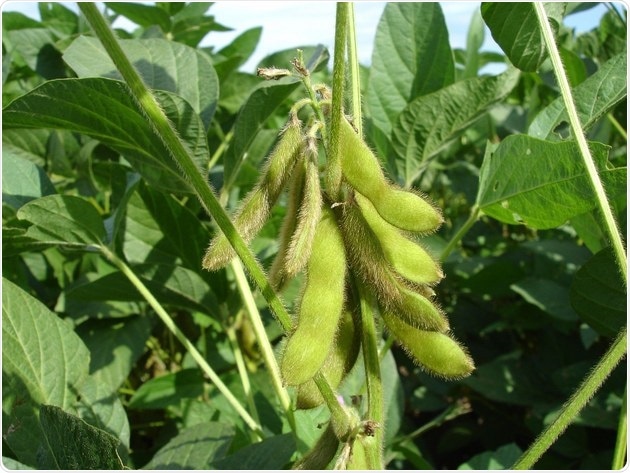Phytoalexins are essentially bioactive phytochemicals. In the last few years, these substances have attracted a great deal of interest because of their major role in plant health and their health-promoting effects in humans.

Soy plants produce glyceollins in response to pathogen attacks such as fungi, bacteria or UV irradiation, in order to maintain their health. Image Credit. Technische Universität Dresden.
At Technische Universität Dresden (TU Dresden), chemists have recently developed a novel and highly efficient technique for synthesizing these phytochemicals. Through this latest technique, chemists are presenting new opportunities for a simpler synthesis of phytoalexins and thus for extensive analyses into their effects, specifically with respect to their positive effect in the fight against cancer.
A balanced diet allows humans to consume larger quantities of phytoalexins daily in a healthy and natural way. Phytoalexins are a type of phytochemicals generated by plants as an immune reaction to specific stimuli to sustain their own health.
Many scientific studies have already demonstrated that such bioactive natural products also benefit humans by imparting a health-promoting effect.
But to study the mechanisms of action more thoroughly, the individual phytoalexins should be obtained, which has so far been performed only with minimal efficiency and by using harmful substances.
At TU Dresden, Dr. Philipp Ciesielski, and Professor Peter Metz from the Chair of Organic Chemistry I have currently demonstrated an innovative and highly efficient synthesis method for phytoalexins in the leading Nature Communications Journal.
Specifically, the low-level synthesis of the phytoalexins, Glyceollin I and Glyceollin II, which are generated as part of the immune reaction in soybean plants, is a major breakthrough.
Both these natural compounds are defined by a wide range of bioactivities, such as anti-oxidant, health-promoting, antitumor activity, and anti-cholesterolemic effects against Western diseases.
The earlier methods for producing Glyceollin I and Glyceollin II involve using huge amounts of the highly toxic and costly oxidizing agent, called osmium tetroxide, and also large proportions of a relatively costly excipient as a ligand in the crucial step.
By contrast, the recently described synthesis route manages without osmium tetroxide and is relatively more efficient at the same time.
Our synthesis pathway to various phytoalexins now allows easier access to these substances. This is an important basis for further investigations into the biological activity of these natural compounds and may well form the basis for their further development as therapeutics.”
Peter Metz, Professor, Chair of Organic Chemistry I, Technische Universität Dresden
Describing the significance of his publication, Professor Metz concluded, “The path we have described to the basic structure of phytoalexins can also be used by other research groups in the synthesis of related natural and active compounds.”
Source:
Journal reference:
Ciesielski, P & Metz, P (2020) Asymmetric one-pot transformation of isoflavones to pterocarpans and its application in phytoalexin synthesis. Nature Communications. doi.org/10.1038/s41467-020-16933-y.